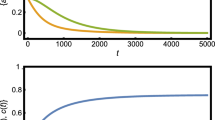Abstract
In this paper a general deterministic discrete-time metapopulation model with a finite number of habitat patches is analysed within the framework of adaptive dynamics. We study a general model and prove analytically that (i) if the resident populations state is a fixed point, then the resident strategy with no migration is an evolutionarily stable strategy, (ii) a mutant population with no migration can invade any resident population in a fixed point state, (iii) in the uniform migration case the strategy not to migrate is attractive under small mutational steps so that selection favours low migration. Some of these results have been previously observed in simulations, but here they are proved analytically in a general case. If the resident population is in a two-cyclic orbit, then the situation is different. In the uniform migration case the invasion behaviour depends both on the type of the residents attractor and the survival probability during migration. If the survival probability during migration is low, then the system evolves towards low migration. If the survival probability is high enough, then evolutionary branching can happen and the system evolves to a situation with several coexisting types. In the case of out-of-phase attractor, evolutionary branching can happen with significantly lower survival probabilities than in the in-phase attractor case. Most results in the two-cyclic case are obtained by numerical simulations. Also, when migration is not uniform we observe in numerical simulations in the two-cyclic orbit case selection for low migration or evolutionary branching depending on the survival probability during migration.
Similar content being viewed by others
References
Dieckmann, U. (1997a). Can adaptive dynamics invade? Trends Ecol. Evol. 12, 128–131.
Dieckmann, U. (1997b). The dynamical theory of coevolution, PhD thesis, University of Leiden.
Doebeli, M. (1995). Dispersal and dynamics. Theor. Pop. Biol. 47, 82–106.
Doebeli, M. and G. D. Ruxton (1997). Evolution of dispersal rates in metapopulation models: branching and cyclic dynamics in phenotype space. Evolution 51, 1730–1741.
Geritz, S. A. H. (1998). The evolutionary significance of variation in seed size, PhD thesis, University of Leiden.
Geritz, S. A. H., È. Kisdi, G. Meszéna and J. A. J. Metz (1998). Evolutionarily singular strategies and the adaptive growth and branching of the evolutionary tree. Evol. Ecol. 12, 35–57.
Geritz, S. A. H., J. A. J. Metz, È. Kisdi and G. Meszéna (1997). Dynamics of adaptation and evolutionary branching. Phys. Rev. Lett. 78, 2024–2027.
Gyllenberg, M., A. V. Osipov and G. Söderbacka (1996). Bifurcation analysis of a metapopulation model with sources and sinks. J. Nonlinear Sci. 6, 1–38.
Gyllenberg, M., G. Söderbacka and S. Ericsson (1993). Does migration stabilize local population dynamics? Analysis of a discrete metapopulation model. Math. Biosci. 118, 25–49.
Hanski, I. A. and M. E. Gilpin (Eds) (1997). Metapopulation Biology: Ecology, Genetics, and Evolution, Academic Press.
Hastings, A. (1983). Can spatial variation alone lead to selection for dispersal. Theor. Pop. Biol. 24, 244–251.
Hastings, A. (1993). Complex interactions between dispersal and dynamics: lessons from coupled logistic equations. Ecology 74, 1362–1372.
Holt R. D. (1985) Population dynamics in two-patch environment: some anomalous consequences of an optimal habitat distribution Theor. Pop. Biol. 28, 181–208.
Holt, R. D and M. A. McPeek (1996). Chaotic population dynamics favors the evolution of dispersal. Am. Nat. 148, 709–718.
Levins, R. (1969). Some demographic and genetic consequenses of environmental heterogeneity for biological control. Bull. Entomol. Soc. Am. 15, 237–240.
Levins, R. (1970). Extinction, in Some Mathematical Problems in Biology, M. Gerstenhaber (Ed.), Providence, RI: American Mathematical Society, pp. 77–107.
Maynard Smith, J. (1976). Evolution and the theory of games, Am. Sci. 64, 41–45.
Metz, J. A. J., S. A. H. Geritz, G. Meszéna, F. J. A. Jacobs and J. S. van Heerwaarden (1996). Adaptive dynamics, a geometrical study of the consequences of nearly faithful reproduction, in Stochastic and Spatial Structures of Dynamical Systems, S. J. van Strien and S. M. Verduyn Lunel (Eds), Amsterdam: North-Holland, pp. 183–231.
Metz, J. A. J., R. M. Nisbet and S. A. H. Geritz (1992). How should we define “fitness” for general ecological scenarios? Trends Ecol. Evol. 7, 198–202.
Ricker, W. E. (1954). Stock and recruitment. J. Fisheries Res Board Can. 11, 559–623.
Author information
Authors and Affiliations
Rights and permissions
About this article
Cite this article
Parvinen, K. Evolution of migration in a metapopulation. Bull. Math. Biol. 61, 531–550 (1999). https://doi.org/10.1006/bulm.1999.0100
Received:
Accepted:
Issue Date:
DOI: https://doi.org/10.1006/bulm.1999.0100



